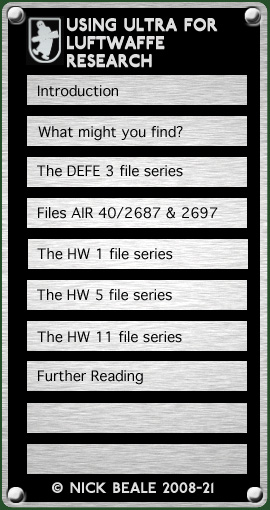These were the first items released to the UK National Archives. Among the many different things in the DEFE 3 series are the “Teleprinted Translations of Decrypted German Naval Radio Messages” (the material quoted in Robert Harris’s novel Enigma) as well as Italian naval and Japanese material. However, what we’re interested in here is the “Main Series of Signals Conveying Intelligence to Allied Commands.” If you thought the file numbering ran from “DEFE 3/1 = start of war” to “DEFE 3/1021 = end of war”, I’m afraid it’s not that simple. Just because one file follows another, it doesn’t necessarily cover the next chronological period. You have to zigzag through the index to follow the progress of the conflict, so I've made a list of the file references, the dates covered by each and the message serial numbers, which can be found here. Originally these files were available in hard copy bound volumes but perhaps because the individual messages were on such flimsy paper, they moved to microfilm and a reel normally held from one to three files in numerical sequence. Now they can be viewed on computer terminals at the Archives or online, or downloaded free at home, one file at a time, in pdf format (document size is about 120 mb). Usually, a “Main Series” file covers about three days of decrypts and includes 250 messages. The days covered by a file are not the dates of the German messages but the dates the Allied reports were issued. Once you have found the file you want in the National Archives online catalogue: To download the entire file free of charge, click the “Add to basket” button, go to the top right of the page and click on the shopping trolley icon. In your basket will be an item priced at £0.00; click the “Checkout” button, then “Submit order” and so on until you get to the “Download” button. Or … When you’ve found your file in the catalogue you’ll see, on a pale yellow background, “This record is available to view with our image viewer. Show images.” Click on those last two words and you’ll be taken to the viewer, which takes a few seconds to load. The control buttons at the top of the viewer are self-explanatory; below these is the message itself. Below that you may see thumbnails of four frames, with arrows to the left and right which move you four frames forward or back. (Not all files seem to have these thumbnails, though). In the centre at the bottom of the viewer is a dropdown menu saying “Image [1] of 301” (or however many there are in the file); this is a quick way of getting nearer to a message iwhose serial number you know. It’s worth noting that because these files originated on paper the most recent item (and highest serial number) was on top and thus comes first in the digital version. (From memory, the occasional file does run lowest-to-highest serial but this seems to be the exception). Format of the messages Each message carries an identifying number, e.g. HP 8534. There are various series including VL, HP and BT; they follow on one after another and all have 9999 messages in them (except for series KO — the European war ended before they’d used up all the numbers). Before the message proper begins there are whole bunch of letters in pairs which seem to denote the various Allied commands the report is being sent to. Then you get anything from Z to ZZZZZ. This is an indicator of the urgency of the message — broadly speaking Z would be information about something that happened a while ago; ZZZZZ would be about something that hadn’t happened yet. The more Zs the greater the recipient’s chance of doing something about the content of the message. Sometimes different theatres of operations get different priority, e.g. “WEST ZZZ, MED Z” depending on how important the message was to each one. With late-war Luftwaffe material the interval between the German transmission and the Allied report is usually less than 24 hours although you’ll find the odd example with a delay of several days or even a couple of weeks. You can tell because the Allied text will often begin something like “REPORT OF SIXTEEN HOURS FOURTEENTH” then at the end is a code for the time the decrypt was issued: 021418Z/12/44. This breaks down as: 02.14 hours / 18th / December / 1944. The “Z” denotes Greenwich Mean Time and every time mentioned in an Ultra message was adjusted to that standard. The messages have a style of language all their own, a bit like reading a telegram. The style is very terse, they use only upper case letters and numbers are often spelled out. They use a lot of abbreviations for English translations of German terms: ARC = Aerodrome Regional Command = Flughafen Bereich. Other examples include: ABLE OBOE or AO (Air Officer, so “AO for Fighters” = General der Jagdflieger) and AMC (Air Movements Control). It’s also helpful to know the Anglo-American phonetic alphabet of the period. ABLE, BAKER, CHARLIE, DOG, EASY, FOX, GEORGE, HOW, ITEM, JIG, KING, LOVE, MIKE, NAN, OBOE, PETER, QUEEN, ROGER, SUGAR, TARE, UNCLE, VICTOR, WILLIAM, XRAY, YOKE, ZEBRA. For example, a reference to message HP 8534 will often say “HOW PETER EIGHT FIVE THREE FOUR.” continued on next page…
|
|||

